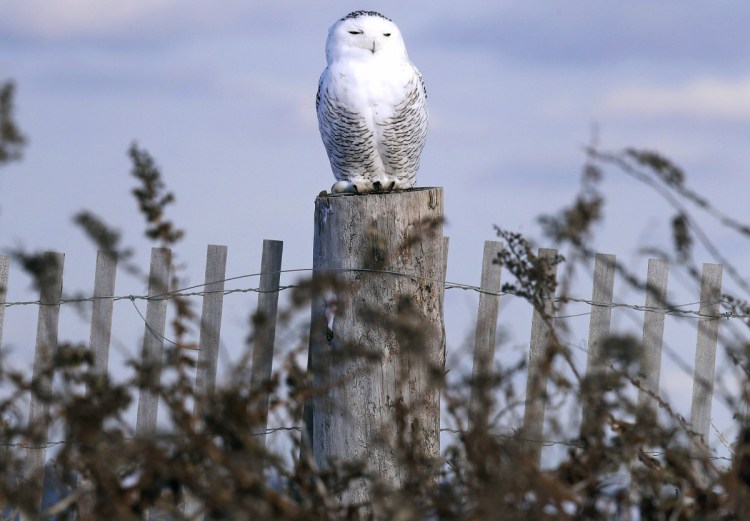Come wintertime, snowy owls, denizens of the Arctic tundra, often grace us with their presence in Maine.
Driven in complex ways by changes in the abundance of their prey supply, specifically lemmings, these charismatic owls sometimes migrate in significant numbers into Maine and elsewhere in the northern United States – and occasionally farther south.
In 2013, ornithologists began a large collaborative, crowd-funded effort to learn more about wintering snowy owls. Called Project SNOWstorm (SNOW is the abbreviation used by bird banders for snowy owls), the project uses solar-powered transmitters to learn about their movements and habits. It’s staffed by a mostly volunteer team of scientists, bird banders and wildlife veterinarians, and is funded by donations.
Unlike satellite transmitters used so effectively to study the movements of albatrosses and other seabirds, these transmitters rely on cellphone networks to detect signals. The transmitters record the position of the bird (latitude, longitude and altitude) as frequently as every six seconds. When a bird is within range of a cellphone tower, the data transmits instantly. If a bird is out of range, the transmitter has enough memory to record 100,000 fixes, downloaded once the bird comes back within range of a tower.
The transmitters are remarkably light, weighing only 1.4 ounces, about 2 percent of an owl’s weight. They are attached to the owls’ backs with a harness. Research shows the backpack doesn’t alter the owls’ behavior or survival.
Let’s look at one snowy owl who was tagged in Wells in January 2017 by Biodiversity Research Institute biologists. Data showed that this adult female nested on the Ungava peninsula in northwestern Quebec in the summer of 2017, then over-wintered in Quebec City. She spent the summer of 2018 on King William Island in the central Canadian Arctic and returned this winter to Quebec City. That’s one traveling lady.
Already the project has greatly increased our knowledge of snowy owl biology. We now know that wintering coastal snowy owls derive much of their food from birds. The transmitters indicate owls fly at night over the open ocean, grabbing sleeping grebes, ducks and gulls.
Another nugget: Researchers were initially confused by a number of tagged snowy owls spending time well offshore on the Great Lakes. The frozen lakes seemed to offer no foraging opportunities, so what were they doing there? But small open patches of water occur on the Great Lakes where ducks congregate, providing easy pickings.
Check out this fantastic project yourself at projectsnowstorm.org.
IN MY LAST three columns, I’ve been detailing who saw what for Maine’s contribution to the 119th Audubon Christmas Bird Count. This week I’d like to finish up with a brief overview.
The most memorable bird on Maine counts this year was one that most Mainers probably already know about, birder or not: the vagrant great black hawk. The hawk, whose home is normally South or Central America, delighted hundreds of birders in December and January at Deering Oaks in Portland, and provided the first sighting of the species on any United States Christmas Count. Unfortunately it came to a very sad end. The bird, whose native habitat is tropical, was rescued during a snowstorm and rushed to Avian Haven in Freedom. But the damage from frostbite proved too severe, and the hawk had to be put down a little over a week later.
Ornithological prognosticators predicted a good invasion year for northern finches. The fall was looking good with lots of pine siskins and evening grosbeaks around. Unfortunately for us, many of these birds seemed to have pushed farther south so were mostly absent on Maine counts. The count also showed that common redpolls, a species that often overwinters on their Arctic nesting grounds, seems to be pushing into northern New England now.
The Maine counts this year produced a number of lingering birds, most of which have reconsidered their decision to stick it out in Maine for the winter. It’s tough for kingfishers or herons to make a living in our frozen winterscape.
These unusual records add spice to any count. But the true value of the counts is to monitor the abundance of regularly occurring birds. One species that bears watching is the blue jay. Their numbers have been declining in the Northeast over the past few years. The next step is to understand a reason for these declines. A big thanks to all who participated in one or more Christmas counts this year. Citizen science is so powerful.
Herb Wilson teaches ornithology and other biology courses at Colby College. He welcomes reader comments and questions at
whwilson@colby.edu
Send questions/comments to the editors.



Success. Please wait for the page to reload. If the page does not reload within 5 seconds, please refresh the page.
Enter your email and password to access comments.
Hi, to comment on stories you must . This profile is in addition to your subscription and website login.
Already have a commenting profile? .
Invalid username/password.
Please check your email to confirm and complete your registration.
Only subscribers are eligible to post comments. Please subscribe or login first for digital access. Here’s why.
Use the form below to reset your password. When you've submitted your account email, we will send an email with a reset code.